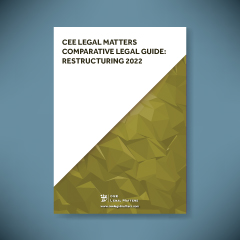Contributed by Kocian Solc Balastik.
1. Overview
1.1. What domestic pieces of legislation and international instruments apply to restructuring and insolvency matters in your jurisdiction?
The primary legislation governing insolvency and restructuring proceedings in the Czech Republic is:
- Act No. 182/2006 Coll., on Insolvency and Its Resolution (Insolvency Act);
- European Regulation No. 2015/848 on Insolvency Proceedings.
Restructuring and insolvency matters are further regulated by:
- Act No. 99/1963 Coll., Civil Procedure Code, which applies to insolvency proceedings and incidental disputes where appropriate;
- Act No. 312/2006 Coll., on Insolvency Administrators (Trustees); and
- Act No. 191/2020 Coll., on Certain Measures to Mitigate the Impact of the SARS CoV-2 Epidemic on Persons Participating in Court Proceedings, Victims, Victims of Crimes and Legal Entities.
1.2. Do you have a well-established legal regime governing restructuring and insolvency, or do you have rather frequent legislative changes in the area?
The Czech Insolvency Act has been amended more than 30 times since 2007, with some of the amendments implementing aspects of European legislation. However, this does not mean the system is not well-established; the insolvency regulation must be able to respond flexibly to changes in society, which naturally requires frequent updates.
1.3. Are there any special regimes applying to specific sectors?
The Insolvency Act does not apply to selected entities, such as the state, self-governing territorial units (regions and municipalities), the Czech National Bank, or public universities. A special regime under the Insolvency Act applies to banks and other financial institutions that are subject to special financial regulation (i.e., savings and credit co-operatives, investment firms, and certain insurance companies).
1.4. Were any changes to restructuring or insolvency laws adopted in response to the COVID-19 pandemic? If so, what were they?
The above-mentioned Act No. 191/2020 Coll. was adopted in response to the COVID-19 pandemic and introduced multiple measures to mitigate the impact of COVID-19 on, inter alia, insolvent persons.
Specifically, Act. No. 191/2020 Coll. amended the Insolvency Act to include a so-called “extraordinary moratorium.” The purpose of the extraordinary moratorium is to provide debtors who ran into temporary problems in connection with the COVID-19 pandemic with an effective instrument of protection against creditors and thus to provide debtors with additional time to solve their financial difficulties. During such an extraordinary moratorium, it is for example not possible to decide on the debtor’s bankruptcy or to enforce a claim against the debtor.
1.5. Are there any proposed or upcoming changes to the restructuring insolvency regime in your country?
In January 2022, a draft law on preventive restructuring was submitted to the Czech government for consideration. The bill aims to transpose Directive 2019/1023 on restructuring and insolvency. Preventive restructuring is supposed to represent a new legal institute intended for entrepreneurial legal entities in temporary financial difficulties. According to the proposed bill, the entrepreneur achieves its recovery mainly through negotiations with creditors over a restructuring plan. The goal of preventive restructuring is to avert impending bankruptcy in a timely and effective manner.
1.6. Has your country adopted or is your country considering the adoption of the UNCITRAL Model Law on Enterprise Group Insolvency?
The UNCITRAL Model Law on Enterprise Group Insolvency has not been adopted in the Czech Republic as such. However, its provisions have been taken into account during the legislative process in the area of Czech insolvency law.
2. Insolvency
2.1. Is there an insolvency test that triggers certain obligations for directors or officers of the debtor company? If so, what is the test and what are the consequences for failure to meet these obligations?
There are two tests under the Insolvency Act:
1) The insolvency test, under which the debtor is considered insolvent if they have multiple creditors, monetary obligations for a period longer than 30 days after the due date, and are not able to fulfill them.
2) The over-indebtedness test, under which the debtor is considered insolvent if they have multiple creditors and their aggregate liabilities exceed the value of their assets.
If the directors of a company (or liquidator) fail to file for insolvency when one of the tests is fulfilled, each of them shall be personally liable for damages to the creditors. Failure to file for insolvency may also trigger criminal liability.
2.2. What types of insolvency procedures are established by law in your jurisdiction?
There are three ways of resolution of insolvency in the Czech Republic – bankruptcy, reorganization (restructuring), and debt relief. Bankruptcy and reorganization are available both to natural and legal persons; debt relief is only available to natural persons and to legal persons who are not entrepreneurs.
2.3. Who has the right to initiate insolvency proceedings?
Insolvency proceedings are always initiated by an insolvency motion to the insolvency court. The insolvency motion may be filed by the debtor (who has an obligation to file for insolvency without undue delay after they became aware, or with due care should have been aware of their insolvency), or its creditor(s).
2.4. What are the consequences of commencing insolvency proceedings, in particular:
There are several significant consequences associated with the commencement of insolvency proceedings. For example, claims that can be registered in the insolvency proceedings cannot be asserted by a lawsuit, the enforcement proceedings may be initiated and enforcement ordered but it cannot be carried out, etc.
Other important consequences are connected with the insolvency court’s decision on the debtor’s insolvency. Primarily, the decision on insolvency suspends judicial and arbitration proceedings on claims and other rights relating to a property, which should be registered in the insolvency proceedings by application, or which are regarded in the insolvency proceedings as having been registered, or on claims which are not satisfied in the insolvency proceedings, and new proceedings in such cases cannot be initiated.
2.4.1. Does management continue to operate the business and/or is the debtor subject to supervision?
In general, the management remains in charge of the debtor’s assets until the insolvency court decides on the method of resolving the debtor’s insolvency.
If the debtor’s bankruptcy is declared, the competence to dispose of the debtor’s assets passes to the insolvency trustee. For reorganization (restructuring), please see Section 3.4.1.
2.4.2. Does a moratorium or stay apply and if so, can it have an extraterritorial effect?
Yes, a legal person or a natural person who is an entrepreneur may ask the insolvency court to declare a moratorium, under the conditions set out in the Insolvency Act. As a result, the court may not declare the debtor’s insolvency until the end of the moratorium period, which may not be longer than three months.
Yes, the moratorium has an extraterritorial effect.
For extraordinary moratoriums, please see Section 1.4.
2.4.3. How does it impact the existing contracts (e.g., is the counter-party free to terminate them, can the debtor’s pre-insolvency transactions be challenged)?
The Insolvency Act sets out the impact of bankruptcy on several types of contracts, including contracts on mutual performance, fixed-term contracts, and loan and lease contracts. In general, the insolvency trustee may refuse the performance of these contracts under certain statutory conditions.
The Insolvency Act provides for two options to challenge a debtor’s pre-insolvency transactions:
1) Invalidity – if the debtor’s legal act is found to be invalid by the insolvency court, the pecuniary gain obtained must be surrendered to the insolvency estate;
2) Ineffectuality – the insolvency trustee may challenge a debtor’s valid legal acts by which the debtor reduced the possibility of satisfying creditors or favored some creditors at the expense of others. An ineffective legal act remains valid but the person who benefited from the legal act is obliged to provide equivalent compensation to the insolvency estate.
2.5. Which steps do insolvency proceedings normally include and what are the roles of the courts and other key stakeholders (such as debtor, directors of the debtor, shareholders of the debtor, secured creditors, unsecured creditors, etc.)?
The basic steps of the insolvency proceedings are normally as follows:
1) Filing for insolvency – motion filed by the debtor or creditor (see Section 2.3.)
2) Assessment of the debtor’s insolvency by the insolvency court
3) Decision of the insolvency court on the debtor’s insolvency
4) Registration of claims – claims may be registered from the commencement of the insolvency proceedings until the deadline set out in the decision on the debtor’s insolvency
5) The creditors’ meeting
6) Decision of the insolvency court on the method of resolving the debtor’s insolvency
7) Review of the registered claims
8) Implementation of the chosen method of resolving the debtor’s insolvency
9) Termination of the insolvency proceedings
Creditors have multiple rights within the insolvency proceedings, such as the right to vote at the meeting of creditors or to challenge registered claims of other creditors.
Secured creditors have a privileged position in the insolvency proceedings as their claims are satisfied preferentially from the security. They also have significant rights in relation to managing and monetizing the secured property, especially the right to give binding instructions to the insolvency trustee in this regard.
For the role of the debtor and its directors in the insolvency proceedings, see especially Sections 2.4.1. and 3.4.1.
2.6. In insolvency proceedings, do specific stakeholders’ claims enjoy priority (e.g., employees, pension liabilities)? Can the claims of any class of creditor be subordinated (e.g., equitable subordination)?
Yes, certain claims do enjoy priority in the insolvency proceedings. The claims are satisfied in the following order of priority:
1) Claims against the insolvency estate (e.g., advance payment for the costs of insolvency proceedings, cash expenses and remuneration of the insolvency trustee, taxes and other public charges, etc.) and claims in equal ranking to them (e.g., claims of employees, claims from pension insurance, etc.).
2) Claims of secured creditors – they are satisfied with the monetization of the asset by which their claim was secured.
3) Claims of unsecured creditors – they are satisfied proportionately from the proceeds of the sale of the debtor’s property, which is not subject to security.
4) Subordinated claims – they can be satisfied only after all other claims have been fully satisfied.
5) Excluded claims – these are not satisfied at all in the insolvency proceedings (e.g., claims from gift contracts, contractual penalties arising after the date of declaration of insolvency, etc.).
2.7. What is a timeline for insolvency proceedings and how are they finalized?
Creditors must register their claims in the period from the commencement of the insolvency proceedings until the deadline set out in the decision on the debtor’s insolvency.
When the insolvency court declares the debtor’s insolvency, it sets a date for the review meeting, where the registered claims are reviewed. The meeting must take place within seven days to two months of the deadline for the registration of claims. The insolvency court also calls the creditors’ meeting to take place no later than three months after the declaration of insolvency. Afterward, the timeline depends on the method of resolving the debtor’s insolvency.
If the debtor’s insolvency is resolved by bankruptcy, the insolvency proceedings are terminated upon the cancellation of the debtor’s bankruptcy by the insolvency court after all of the debtor’s assets have been monetized.
In the case of debt relief, the insolvency proceedings end with the insolvency court’s decision, in which the court takes note of the discharge of the debtor’s debt and by which it exempts the debtor from paying the remaining debts.
For reorganization, see Section 3.7.
2.8. Are there any liabilities that survive the insolvency proceedings?
If the debtor’s insolvency is resolved by bankruptcy, the debtor’s liabilities that have not been satisfied continue to exist and may be enforced through enforcement proceedings.
In restructuring, the debtor pays its liabilities continuously throughout the reorganization. If the insolvency court decides to cancel the reorganization plan, the creditors can without further ado demand the satisfaction of their claims and other rights they had before its approval. The claims of creditors and third parties established by the reorganization plan are not affected.
In the case of debt relief, at the end of the insolvency proceedings, the debtor is granted exemption from paying outstanding liabilities if they have duly fulfilled the conditions of the debt relief.
3. Restructuring
3.1. What formal and informal restructuring proceedings are available in your country?
Under the Insolvency Act, a formal reorganization (restructuring) is available as one of three methods of resolving the debtor’s insolvency.
Czech insolvency law recognizes so-called “pre-packaged reorganizations.” In pre-packaged reorganizations, when the debtor files for insolvency, they may also submit a reorganization plan which has been already approved by at least half of all secured and half of the unsecured creditors (calculated according to the amount of their claims). This way, even debtors who do not fulfill the criteria for reorganization (see Section 3.2.) are able to resolve their insolvency through restructuring.
3.2. What are the entry requirements to restructuring and how are restructuring plans approved and implemented?
In general, reorganization is permissible if the total annual net turnover of the debtor for the last accounting period preceding the insolvency proposal reached at least CZK 50 million (approximately EUR 2 million), or if the debtor employs at least 50 employees. On the other hand, reorganization is not permissible if the debtor is a legal entity in liquidation, a securities trader, or a person authorized to trade on a commodity exchange.
The reorganizational plan is usually drawn up by the debtor. It must be approved by the creditors’ meeting and afterward by the insolvency court. The debtor and the insolvency trustee cooperate in the implementation of the reorganizational plan. The creditors’ committee oversees the implementation.
3.3. Who has the right to initiate formal restructuring proceedings?
The motion to approve the reorganization can be filed by the debtor or a registered creditor. The person who files the motion to approve reorganization must in good faith believe that all the conditions for the approval of the reorganization plan are or will be fulfilled.
3.4. What are the consequences of commencing restructuring proceedings, in particular:
3.4.1. Does management continue to operate the business and/or whether the debtor is subject to supervision?
Throughout the reorganization, the debtor stays in possession of its assets, administers and disposes of its assets, and continues its business activities. These activities are supervised by the insolvency trustee, the creditors’ committee, and the insolvency court. The debtor is obliged to comply with the approved reorganization plan and refrain from any acts that might thwart its fulfillment. Fundamental decisions and dispositions may be taken only with the consent of the creditors’ committee.
3.4.2. Does a moratorium or stay apply, and, if so, what is its scope?
Yes, see Section 2.4.2.
3.4.3. How do restructuring proceedings affect existing contracts?
The same rules as in bankruptcy apply, see Section 2.4.3. Generally, the debtor continues its business activities. However, if a contract is not fully fulfilled by either the debtor or the other party at the time of the commencement of a reorganization, the debtor may reject the performance of such contracts within a 30-day period, with the consent of the creditors’ committee. In such a case, the other party may claim compensation for damage caused, but no later than 30 days after the date of rejection.
3.4.4. How are existing contracts treated in restructuring and insolvency processes?
See Sections 2.4.3. and 3.4.3.
3.5. Can third-party liabilities be released through restructuring proceedings?
No, third-party liabilities cannot be released in reorganizations.
3.6. Which steps do restructuring proceedings normally include and what are the roles of the courts and other key stakeholders (such as debtor, directors of the debtor, shareholders of the debtor, secured creditors, unsecured creditors, etc.)?
The basic steps of the reorganization are as follows:
1) The decision of the insolvency court on the debtor’s insolvency
2) The motion to approve reorganization – can be filed by the debtor until the decision of the insolvency court on the debtor’s insolvency, or in other cases, no later than 10 days before the first creditors’ meeting that is to take place after the decision on the debtor’s insolvency
3) Approval of the motion to approve reorganization by the creditors’ meeting
4) The decision of the insolvency court on the approval of the reorganization
5) Submission of the reorganizational plan to the insolvency court
6) Approval of the reorganizational plan by the creditors’ meeting
7) Approval of the reorganizational plan by the insolvency court
8) Implementation of the reorganizational plan
9) Termination of the insolvency proceedings
In reorganizations, all rights of unsecured (as well as secured) creditors derive from a reorganization plan. The debtor may dispose of its assets in accordance with the reorganization plan under the supervision of the insolvency trustee and the creditors’ committee. Sales and similar transactions that have been pre-negotiated prior to a reorganization (or the opening of insolvency proceedings) may be effectuated only if such transaction is included in the reorganization plan.
3.7. How are restructuring proceedings normally finalized?
In reorganizations, the insolvency proceedings are finalized by the insolvency court’s decision on a) the cancellation of the decision on approval of the reorganizational plan, b) the transformation of reorganization into bankruptcy, or c) the end of reorganization after the reorganizational plan was fulfilled.
4. Cross-border restructuring and insolvency
4.1. Do domestic courts in your country recognize foreign insolvency or restructuring proceedings over a local debtor?
Yes, foreign insolvency or restructuring proceedings are recognized in the Czech Republic.
4.2. What are the preconditions for recognizing foreign decisions?
In general, a foreign decision that is in legal force and enforceable may be recognized in the Czech Republic, provided that mutual recognition is guaranteed by the country whose public authority issued the decision. Decisions issued by the EU courts are recognized in the Czech Republic in accordance with the EU Insolvency Regulation (see Section 4.3.)
The recognition of a foreign decision in property matters is not declared by a special decision. A foreign decision is recognized by the Czech public authority taking it into account as if it were a decision of a Czech public authority. Foreign decisions in other matters are declared by a special decision.
4.3. Do domestic courts cooperate with their counterparts in other jurisdictions and if so, what does such recognition depend on (such as the COMI of the debtor, the governing law of the debt to be compromised, etc.)?
Yes, Czech courts cooperate with their counterparts in other jurisdictions.
Insolvency proceedings opened in another Member State of the EU are recognized in the Czech Republic in accordance with the EU Insolvency Regulation. In respect of insolvency proceedings opened in non-EU countries, Czech Act No. 91/2012 Coll., on International Private Law provides that foreign judgments rendered on insolvency proceedings are recognized in the Czech Republic on the condition of reciprocity, provided that the center of the debtor’s main interests is situated in the foreign country that issued the judgment, and that the debtor’s assets located in the Czech Republic have not been subject to already pending insolvency proceedings before Czech courts.
The EU Insolvency Regulation provides a general framework for mutual cooperation and communication between insolvency trustees and insolvency courts across the European Union, in order to facilitate the coordination of cross-border insolvency proceedings concerning the same debtor.
4.4. How are foreign creditors treated in restructuring and insolvency proceedings in your jurisdiction?
Foreign creditors are treated equally to domestic creditors under Czech law, in compliance with the principle of the equal treatment of creditors.
5. Summary
5.1. Overall, do you have a more creditor-friendly or debtor-friendly restructuring and insolvency regime in your jurisdiction?
Generally, the Czech insolvency proceedings are more debtor-friendly. On average, secured creditors get paid approximately 25% of the value of their registered claims, and unsecured creditors receive only approximately 4%. Moreover, the insolvency trustee has a wide range of options to challenge creditors’ claims, even those that are enforceable.





